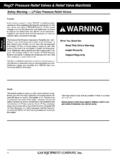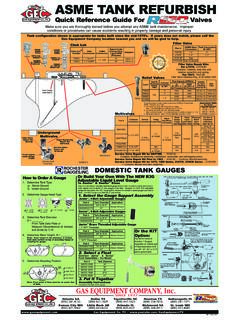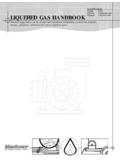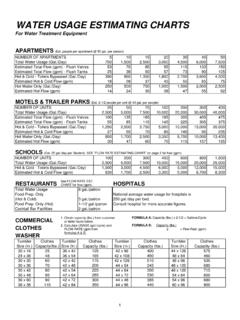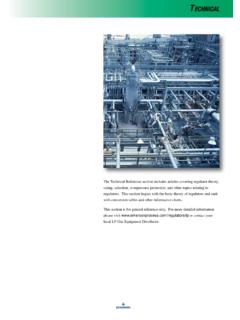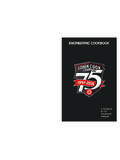Transcription of STEPS TO COMPRESSOR SELECTION & SIZING
1 04/99 CB-207. COMPRESSORS. STEPS TO COMPRESSOR SELECTION & SIZING . I Understand the Application What is the COMPRESSOR supposed to do? II Find Out the Details Gas, pressures, temperatures, capacities, III Scope of Supply Who is to supply the motor, switchgear, piping, IV Size the COMPRESSOR V Select Accessories When all of the above has been done, this information can be combined with what is known about the customer's 'needs/desires' to generate a successful quotation. page 2 COMPRESSOR SIZING 04/99 CB-207. step I - Understand the Application Become familiar with the big picture before getting into the details of the application. 1. Form a clear, concise statement describing the purpose of the COMPRESSOR .
2 2. Many compressors operate at more than one condition. Determine why and how often the various conditions occur. Examples: This COMPRESSOR is to transfer liquid propane from railcars into a bulk storage tank. After the liquid has been transferred, the remaining vapors will be recovered. The COMPRESSOR will operate year around, emptying about 2 railcars per week. This COMPRESSOR will be used to evacuate a vessel at the end of a batch process. It will be used in a production facility that will perform 6 batch operations in a 16 hour day. NOTE THAT DETAILS LIKE PRESSURES, TEMPERATURES & FLOW RATES ARE. NOT NEEDED OR EVEN WANTED AT THIS step . page 3 COMPRESSOR SIZING 04/99 CB-207.
3 step II - Find Out the Details In order to determine what type of COMPRESSOR system will be needed to accomplish the job, a variety of detailed data will need to be discerned. As a minimum, a precise understanding of the following data is required: Gas being handled Suction and Discharge Pressure Site Elevation (or Local Barometric Pressure). Suction Temperature Capacity In addition the following items are needed to help make some subjective decisions when two or more options are available or in the SELECTION of various accessories. 'Normal' operating conditions Other operating conditions Duty Cycle Electrical characteristics and area classification Availability of cooling water Here is a sample problem that we will use to work through the STEPS needed to select a COMPRESSOR and accessories.
4 A COMPRESSOR to be used to draw nitrogen off of a cryogenic storage tank and boost the pressure to feed a number of plant processes. The flow requirement will vary throughout the 8 hour production day, but will average about 15 CFM. Suction: Nitrogen at 5 psi Discharge: 65 psi Site: 1,000 ft. elevation, outdoors, Ambient of 0 to 100 F. Utilities: 460V/3ph/60hz, 80 F fresh water page 4 COMPRESSOR SIZING 04/99 CB-207. step II - (Details) Gas Being Handled The gas to be compressed must be precisely identified. Once the gas has been identified the data for most gasses are readily available from published tables. If it isn't, the customer can often provide the needed information.
5 Gas Name - This may be presented as a chemical formula, a common name or a trade name. For example, dichlorodifluoromethane has a chemical formula of C Cl2 F2, a DuPont trade name of Freon 12, and a common name of refrigerant 12 or R12. Each gas has a number of physical data that must be known. For most gasses, these values are easily found if the gas has been precisely identified. (Terms like Freon, LPG, or even natural gas are too generic.). Data needed for Molecular Weight Critical Pressure each gas. "n" Value Critical Temperature Gas Mixtures - A gas stream containing more than one gas may be presented with the MW, "n" value, and critical values already calculated for the mixture.
6 Alternately, the specification may list the individual gasses and their percentage of the total. The percentages may be expressed on a volume (molar) or weight basis. The basis being used must be known! Procedures for calculating average values for the total gas stream will be presented later. In our example the gas is given as nitrogen from a cryogenic vessel. In this case the gas stream should be 100% N2 with virtually no measurable contaminants. MW = Critical Pressure = 493 psia "n" value = Critical Temperature = 228 R. page 5 COMPRESSOR SIZING 04/99 CB-207. step II - (Details) Gas Being Handled Molecular Weight - The molecular weight of most gasses is fairly easy to find in published tables.
7 For some gasses (particularly natural gas) the "specific gravity". may be given. The molecular weight can easily be determined from the specific gravity: MW = SG ( ). R12 has a MW = and a SG = "n" Value - This is known as the specific heat ratio and is listed in many published tables. If the "n" value is not given, another value called the specific heat at constant pressure (Cp) may be used to calculate the "n" value. The formula is: n= MW (Cp). MW (Cp) - Critical Pressure (Pc) and Critical Temperature (Tc) - These two values are used to calculate a value called compressibility (Z). Both Pc and Tc are published for most gasses. Charts or a computer program are used to calculate the Z value from the critical pressure and the critical temperature.
8 For hand calculations or estimating purposes the compressibility factor may usually be ignored when SIZING Blackmer compressors. The error introduced in most cases is small and the resulting calculation will size the COMPRESSOR slightly larger than necessary. page 6 COMPRESSOR SIZING 04/99 CB-207. step II - (Details) Pressures Values for pressure can also be a source of confusion since there are two distinct methods of expressing pressure - "absolute pressure" and "gauge pressure". In order to size a COMPRESSOR , the pressures must be expressed in "absolute" terms. The relationship between the two systems is: PSIA = PSIG + Pamb Bar-a = Bar-g + Pamb PSIA pounds per square inch, absolute PSIG pounds per square inch, gauge Pamb local barometric pressure (psia or Bar-a).
9 Bar-a Bars, absolute Bar-g Bars, gauge The use of the term "PSI" or "Bar" without an indication as to whether the value is a gauge reading or an absolute measurement must be resolved. Ps SUCTION PRESSURE. The pressure at the COMPRESSOR inlet expressed as psia (or Bar-a). Pd DISCHARGE PRESSURE. The pressure at the COMPRESSOR discharge expressed as PSIA (or Bar-a). In the example, the suction and discharge pressures are given as 5 and 65 psi respectively. As mentioned above, we have to know whether he means 'psia' or 'psig'. In this case the customer advises that he meant 'psig'. These values will have to be converted to 'absolute' terms, but we can't do it until we know the local barometric pressure.
10 Page 7 COMPRESSOR SIZING 04/99 CB-207. step II - (Details) Site Elevation Site Elevation is used to determine the local Barometric Pressure, Pamb). Many of the formulas shown above require knowledge of the local barometric pressure, Pamb. If Pamb is not listed in the specifications it can easily be determined from the table below. Atmoshperic Pressure at Different Altitudes Altitude above sea Atmospheric Altitude above sea Atmospheric level, ft. pressure, psia. level, ft. pressure, psia. 0 7,500 500 8,000 1,000 8,500 1,500 9,000 2,000 9,500 2,500 10,000 3,000 10,500 3,500 11,000 4,000 11,500 4,500 12,000 5,000 12,500 5,500 13,000 6,000 13,500 6,500 14,000 7,000 14,500 In our example, the site data lists an elevation of 1,000 ft.
